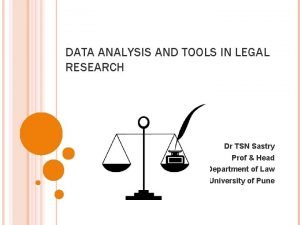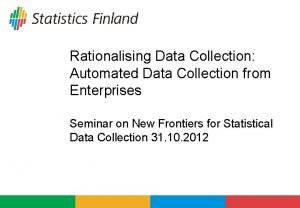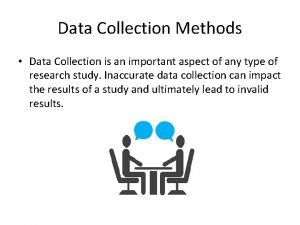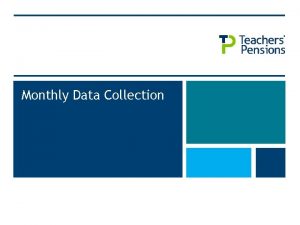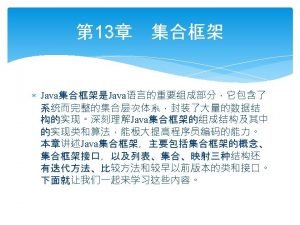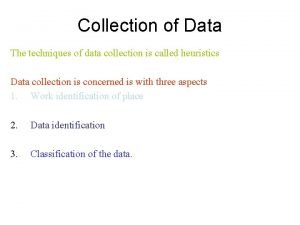METHODS OF DATA COLLECTION A REVIEW OF THE

















- Slides: 17

METHODS OF DATA COLLECTION: A REVIEW OF THE LITERATURE ON USE OF VIDEO TELECONFERENCING Lisa Gray, Dr. Gwen Rempel, & Dr. Gina Wong Faculty of Health Disciplines Focused on the future of learning

Introduction • In-person interviews are known as a standard form of data collection in qualitative studies. 1 • There has been a large amount of literature written about the use of face-toface interviewing. 2 -4 • With the invention and availability of new technology, new methods of collecting data are possible. • Video teleconferencing may provide a cost effective and convenient alternative.

Rationale and Purpose Rationale: Smaller component of a larger qualitative research study, where Adobe Connect will be employed as the means of data collection. Video teleconferencing as a method of collection has not been well explored in the literature. Purpose: Evaluate the current state of knowledge on the practice of using video teleconferencing in qualitative research.

What is it and What do I Need? What is Video Teleconferencing? Video teleconferencing software allows two or more people in different locations to communicate using audio and/or video imaging in real time. 5 What is Required? • Required software • High-speed Internet access • Required hardware • Mobile telephone with video capabilities, if calling in.

Background • Researchers in the past have sought out alternative means to face-toface interviews, starting with telephone interviews. 6 • There has been an increase of online technologies being utilized in research, such as, emailing 7 -8, instant messaging 9, and chat rooms. 10 • Researchers should evaluate the advantages and disadvantages of using video teleconferencing software. 11 -12 • According to the 2012 Canadian Internet Use Survey, 83% of Canadian households have Internet access in their homes. 13

Background (cont. ) • In one study where participants were given a choice between video teleconferencing and a telephone interview, those that choose telephone stated being disappointed that they could not “meet” their interviewer. 15 • Another study found that when given a choice between video teleconferencing and a telephone interview, participants preferred video teleconferencing. 16 • Participants in a study that used emailing stated that they would prefer a faster means of communication. 7

Literature Review Methodology In order to conduct this literature review I utilized Google Scholar and several databases through the Athabasca Library. Inclusion Criteria Exclusion Criteria Articles published between 2000 -2016 Articles published before 2000 Articles published in peer-reviewed journals Articles published in non peer-reviewed journals Articles written in English Articles written in a language another than English Studies using video teleconferencing as a means of data collection Studies that did not use video teleconferencing as a means of data collection Keywords included: (Adobe Connect), (video teleconferencing), (qualitative interviews), (semi-structured interviews), and (data collection).

Literature Review Highlights • Video teleconferencing was typically used to save costs 14 -15, to gain access to a wider population 14 -15, and for practical concerns, such as, weather. 15 • Studies found that participants liked having the option of participating online for flexibility and convenience. 14 • Studies that compared face-to-face versus online interviews did not find negative impacts in terms of quality of the interview. 14, 17 • Some interviewees were more open during online interviews. 14 • One study also noted technical difficulties and interview skills as important considerations. 18

Literature Review Highlights (cont. ) Gaps • Current available literature seemed to be focused on the use of Skype. 12, 14, 19 • One study found that online interviews had a higher rate of absentees. Increased emailing prior to interviews seemed to decrease this, but further research is needed in this area. 14

Things to Consider • Availability of technology • Location • Privacy • Comfort level and ability • Contingency plan in case of technical difficulties • Ethical considerations • Applicability and appropriateness • Rapport • Speak clear, manage background noise, utilize hand gestures and facial expressions, and look into the camera

Why use Video Teleconferencing? • No geographical barriers • Flexibility • Participants may feel more comfortable • Able to observe participants non-verbal and emotional indications • Cost effective and convenient • Possible increased participation • Decreased healthy and safety risks

Disadvantages • Software and hardware requirements • Technical difficulties • Discomfort with technology • Additional ethical considerations • Lack of physical presence • Chosen location may be distracting for participants • Researchers may miss body language or emotional cues

Implications and Conclusion Implications: • Could help researchers to gain access to larger and more diverse sample sizes. • This could potentially lead to more studies and advances in our field. Conclusions: • Although there are many advantages, it is important for researchers to be aware of the disadvantages as well. • Researchers should ensure that using this method of data collection is appropriate for their specific study and participant population.

References 1. Creswell, J. W. (2013). Qualitative inquiry and research design: Choosing among five approaches (3 rd ed. ). Los Angeles: Sage Publications. 2. Opdenakker, R. (2006). Advantages and disadvantages of four interview techniques in qualitative research. Forum: Qualitative Social Research, 7(4), 1. Retrieved from http: //www. qualitative-research. net/index. php/fqs/article/view/175 3. Di. Cicco-Bloom, B. , & Crabtree, B. F. (2006). The qualitative research interview. Medical Education, 40(4), 314– 321. doi: 10. 1111/j. 1365 -2929. 2006. 02418. x 4. Gill, P. , Stewart, K. , Treasure, E. , & Chadwick, B. (2008). Methods of data collection in qualitative research: interviews and focus groups. British Dental Journal, 204(6), 291– 295. doi: 10. 1038/bdj. 2008. 192 5. Gough, M. , & Rosenfeld, J. (2006). Video conferencing over IP. [electronic resource] : configure, secure, and troubleshoot. Rockland, MA : Syngress. 6. King, N. & Horrocks, C. (2010). Interviews in qualitative research. London: SAGE Publications Inc. 7. Mason, D. M. , & Ide, B. (2014). Adapting qualitative research strategies to technology savvy adolescents. Nurse Researcher, 21(5), 40– 45. doi: 10. 7748/nr. 21. 5. 40. e 1241 8. James, N. (2015). Using email interviews in qualitative educational research: creating space to think and time to talk. International Journal of Qualitative Studies in Education, 29(2), 150– 163. doi: 10. 1080/09518398. 2015. 1017848 9. Stieger, S. , & Göritz, A. S. (2006). Using Instant Messaging for Internet-Based Interviews. Cyber. Psychology & Behavior, 9(5), 552– 559. doi: 10. 1089/cpb. 2006. 9. 552 10. Shapka, J. D. , Domene, J. F. , Khan, S. , & Yang, L. M. (2016). Online versus in-person interviews with adolescents: An exploration of data equivalence. Computers in Human Behavior, 58, 361– 367. doi: 10. 1016/j. chb. 2016. 016 11. Fielding, N. (2010). Virtual fieldwork using access grid. Field Methods, 22(3), 195 -216. doi: 10. 1177/1525822 X 10374277 12. Nehls, K. , Smith, B. D. , & Schneider, H. A. (2014). Video-Conferencing Interviews in Qualitative Research. In S. Hai-Jew (Ed. ). Enhancing Qualitative and Mixed Methods Research with Technology, 140– 157. doi: 10. 4018/978 -1 -4666 -6493 -7. ch 006

References (cont. ) 13. Statistics Canada. (2013). Canadian Internet use survey, 2012. (Catalogue no. 11 -001 -X). Retrieved from http: //www. statcan. gc. ca/dailyquotidien/131126/dq 131126 d-eng. pdf 14. Deakin, H. , & Wakefield, K. (2013). Skype interviewing: reflections of two Ph. D researchers. Qualitative Research, 14(5), 603– 616. doi: 10. 1177/1468794113488126 15. Sedgwick, M. , & Spiers, J. (2009). The Use of Videoconferencing as a Medium for the Qualitative Interview. International Journal of Qualitative Methods, 8(1), 1 -11. 16. Mabragaña, M. , Carballo-Diéguez, A. , & Giguere, R. (2013). Young women's experience with using videoconferencing for the assessment of sexual behavior and microbicide use. Telemedicine Journal And E-Health : The Official Journal Of The American Telemedicine Association, 19(11), 866 -871. doi: 10. 1089/tmj. 2013. 0008. 17. Cabaroglu, N. , Basaran, S. , & Roberts, J. (2010). A comparison between the occurrence of pauses, repetitions and recasts under conditions of face-to-face and computer-mediated communication: A preliminary study. Turkish Online Journal Of Educational Technology, 9(2), 14 -23. 18. Rowe, M. , Rosenheck, R. , Stern, E. , & Bellamy, C. (2014). Video Conferencing Technology in Research on Schizophrenia: A Qualitative Study of Site Research Staff. Psychiatry: Interpersonal and Biological Processes, 77(1), 98– 102. doi: 10. 1521/psyc. 2014. 77. 1. 98 19. Sullivan, J. R. (2012). Skype: An appropriate method of data collection for qualitative interviews? The Hilltop Review, 6, 54– 60. Retrieved from http: //scholarworks. wmich. edu/hilltopreview/vol 6/iss 1/10

Questions and Comments Does anyone have any questions and/or comments?

Thank you!
 Types of data collection methods
Types of data collection methods Tools how to legal research
Tools how to legal research Observational data collection methods
Observational data collection methods Observation methods of data collection
Observation methods of data collection What is a primary data
What is a primary data Automated data collection methods
Automated data collection methods Landsat collection 1 vs collection 2
Landsat collection 1 vs collection 2 Documentary payment
Documentary payment Data collection procedure
Data collection procedure The terms external secondary data and syndicated
The terms external secondary data and syndicated Collection methods and procedures
Collection methods and procedures Direct wax pattern technique
Direct wax pattern technique Hát kết hợp bộ gõ cơ thể
Hát kết hợp bộ gõ cơ thể Ng-html
Ng-html Bổ thể
Bổ thể Tỉ lệ cơ thể trẻ em
Tỉ lệ cơ thể trẻ em Chó sói
Chó sói Glasgow thang điểm
Glasgow thang điểm

